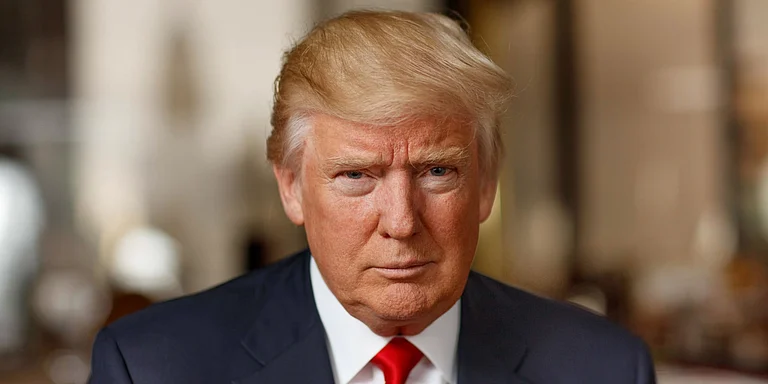US doubles tariff on select Indian goods to 50%, citing Russia oil ties.
Around 55% of Indian exports to the US, worth $86.5bn, face tariff risk.
Key sectors hit include textiles, gems, leather, shrimp and machinery.
Experts urge calm response, export diversification, and strategic trade resilience.
Trade, Tariffs & Tensions: What Donald Trump’s 50% Tariff Means for India’s Export Future
India becomes the most heavily taxed US trading partner after new tariffs hit key sectors. Over half of Indian exports to the US now face higher duties amid geopolitical strain
Tensions between India and the United States deepened this week as President Donald Trump announced an additional 25% tariff on select Indian exports, effectively doubling the duty on the affected goods to 50%. The new tariffs will come into force on 27 August.
The White House called it a response to New Delhi's continued purchase of Russian Federation oil and said that the Trump administration is establishing a process for the potential imposition of similar tariffs on other countries that directly or indirectly import oil from the Russian Federation.
"It is extremely shocking. It will impact India's 55% of exports to US," Federation of Indian Export Organisations (FIEO) DG Ajay Sahai told PTI.
With this development, India becomes the most heavily taxed US trading partner alongside Brazil, far above its rivals such as China, Vietnam and Bangladesh, with the potential to jeopardise most of India’s $86.5bn in annual exports to the US.
Earlier in the week, India had dismissed criticism from Washington and Brussels over its Russian oil imports as “unjustified and unreasonable”, arguing that neither the US nor the EU has completely severed trade ties with Russia.
"In 2024, China bought $62.6bn of Russian oil—more than India’s $52.7 bn—yet faces no such penalties," said Ajay Srivastava, founder of the Global Trade Research Initiative (GTRI). "Washington avoids targeting Beijing because of China’s leverage over critical materials such as gallium, germanium, rare earths and graphite, vital for US defence and technology," he pointed out.
"Two recent events have put a dent in the India-US relationship-one is India not asking for Trump to get a Nobel Peace Prize, and the second is President Putin not agreeing to a ceasefire on Ukraine," said Nachiketa Sawrikar, fund manager at Artha Bharat Global Multiplier Fund.
Impact on Indian Exports
Key sectors such as steel, aluminium, semiconductors, pharmaceuticals and automobiles have so far been spared from the new tariffs. However, textiles—where India competes with Bangladesh, Vietnam, Pakistan and the Philippines—has been hit hard, as these countries face significantly lower US tariffs.
Other impacted sectors include gems and jewellery, shrimp, leather and footwear, animal products, chemicals, and electrical and mechanical machinery.
"This move is a severe setback for Indian exports, with nearly 55% of our shipments to the US market directly affected. The 50% reciprocal tariff effectively imposes a cost burden, placing our exporters at a 30–35% competitive disadvantage compared to peers from countries with lesser reciprocal tariffs," said Sahai.
He added that many export orders have already been put on hold as buyers reassess sourcing decisions in light of higher landed costs.
"For a large number of MSME-led sectors, absorbing this sudden cost escalation is simply not viable. Margins are already thin, and this additional blow could force exporters to lose long-standing clients," Sahai added.
India’s electronics exports to the US have surged from $1.88bn in FY2020 to $14.64bn in FY2025 (a 50.7% CAGR), largely driven by smartphone manufacturing and exports. The market share of electronic goods in India’s US-bound shipments has risen from 4% in FY2021 to 17% in FY2025, while shares of traditional products have remained largely stable.
Agricultural exports such as tobacco, coffee, meat and dairy, cereals, rice, and fruits and vegetables have also posted double-digit CAGRs, reflecting increasing US demand. Petroleum exports rebounded sharply after the FY21 slump, supported by refinery-driven value-added trade. However, traditional sectors like textiles and gems & jewellery remain more sensitive to US policy shifts and demand fluctuations.
Yet, Manoj Mishra, partner and tax controversy management leader, Grant Thornton Bharat (GTB) noted that even as the proposed 25% additional tariffs by the US are a drastic development but India’s merchandise exports to the US at around $87bn in FY25 account for only about 2% of India’s GDP, making it a modest share of the overall economy.
Road Ahead
The announcement comes at a time when a US team is scheduled to visit India from August 25 for the sixth round of negotiations for the proposed bilateral trade agreement (BTA). Experts see the announcement as a pressure tactic to push India into accepting US demands in the negotiations.
Srivastava suggested that India should not abandon Russian oil purchases to satisfy Washington, as it may find a new pretext to tax New Delhi again. "India should remain calm, avoid retaliation for at least six months, and recognise that meaningful trade negotiations with the U.S. cannot proceed under threats or mistrust," he added.
Sanat Kumar, Chief Economist at the PHD Chamber of Commerce and Industry, also downplayed the impact while releasing a White Paper on the impact of Trump Tariffs. “A higher crude oil price poses a far greater threat to India than an elevated US tariff rate,” he said, advocating for strategic responses such as offering bundled services, adopting a ‘China-plus-one’ approach, expanding digital sales channels, and absorbing tariff shocks in the short term. "An elevated crude oil price will even impact those commodities which are produced and consumed in India," Kumar added.
Mishra said the episode highlights the urgency of diversifying India’s export destinations and reducing over-reliance on any one market. He emphasised that leveraging India’s expanding free trade agreement (FTA) network will be key to sustaining long-term export growth.
"The USA consumer will pay a higher price for the pharmaceutical and jewellery exports. India will need to write off about $50bn of exports to the US. That is a 0.1% impact on India’s GDP. Indians will gladly pay that price as self-respect is priceless," Sawrikar added.

